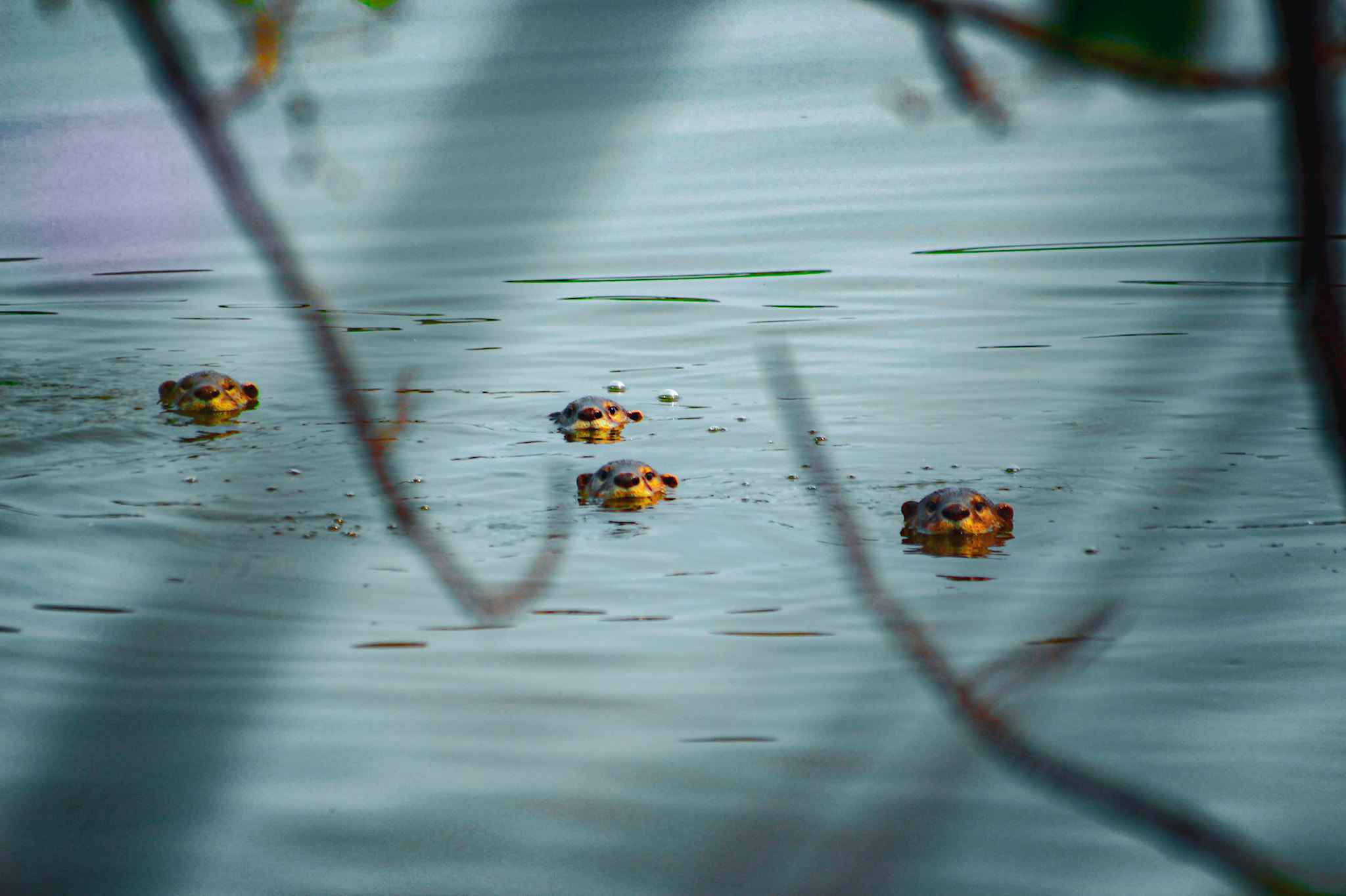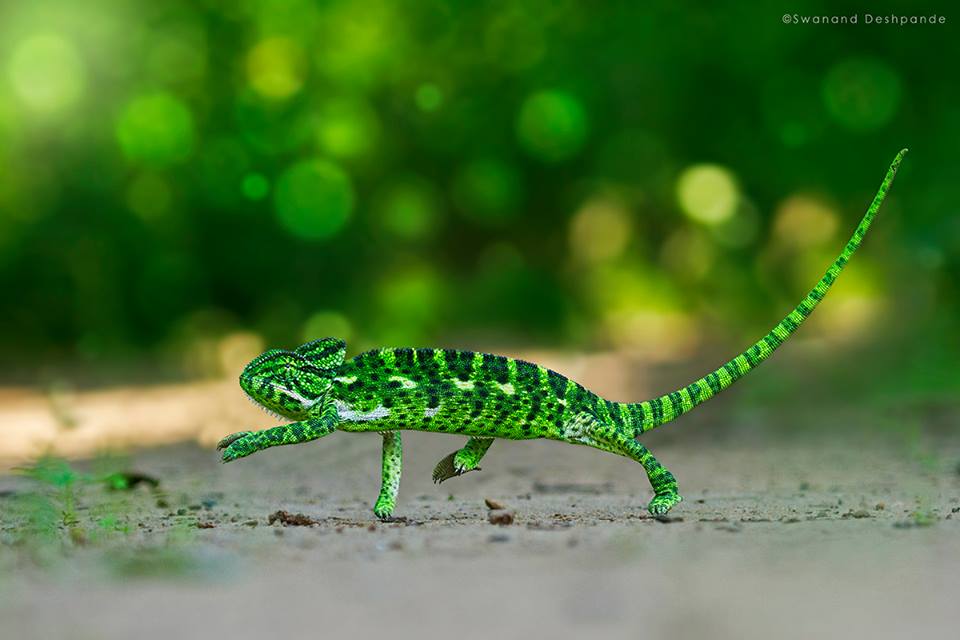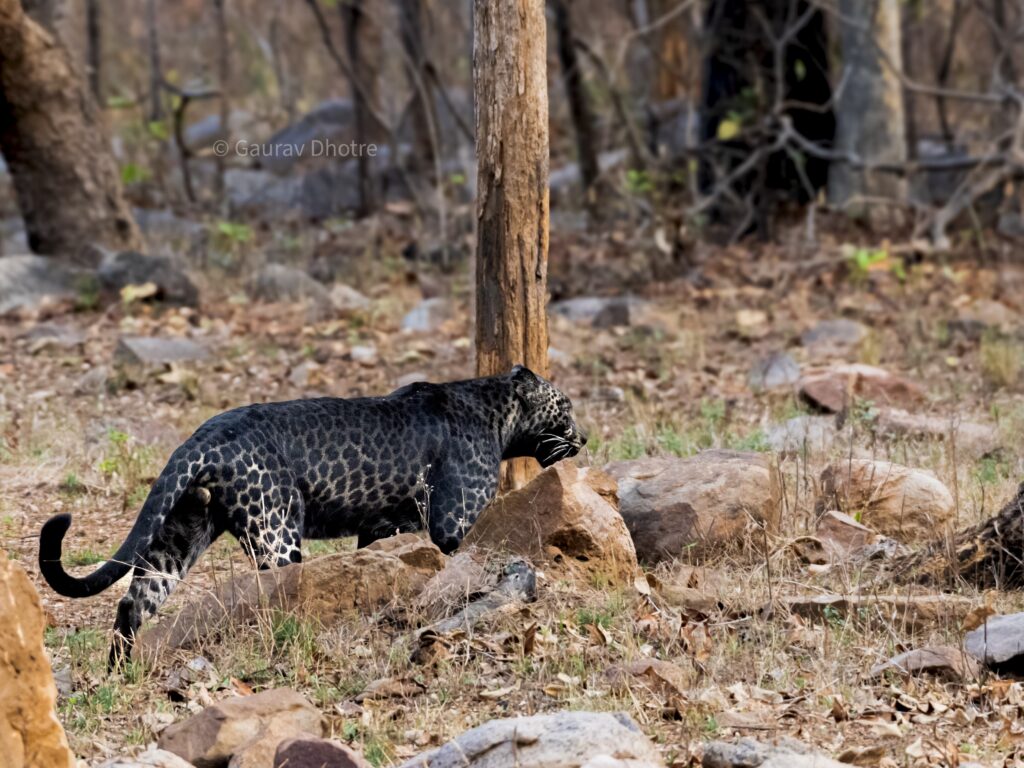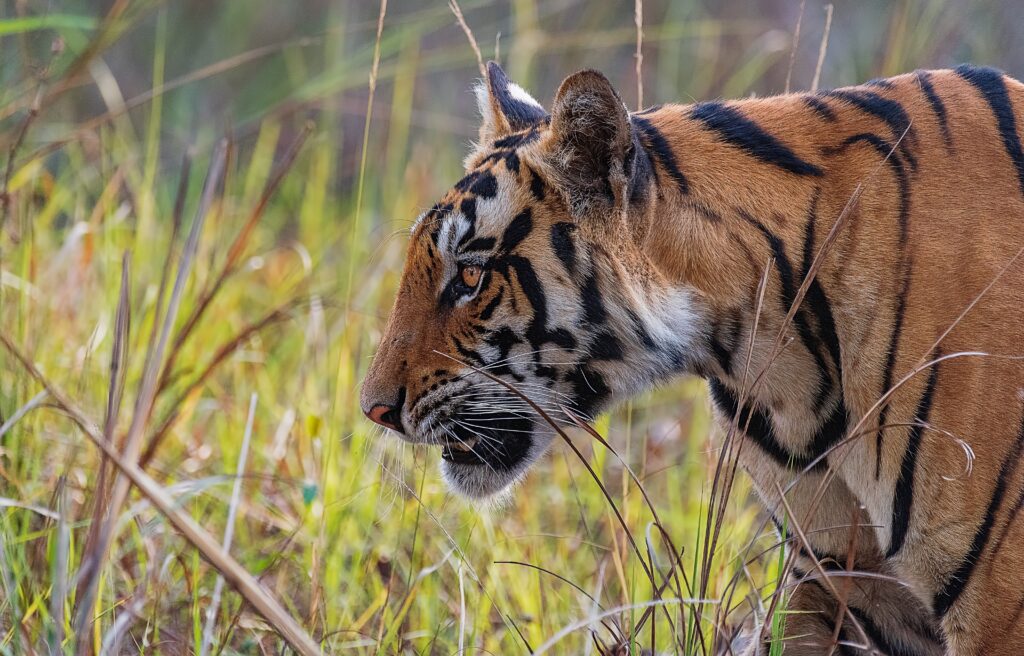THE ENIGMATIC OTTERS in INDIA
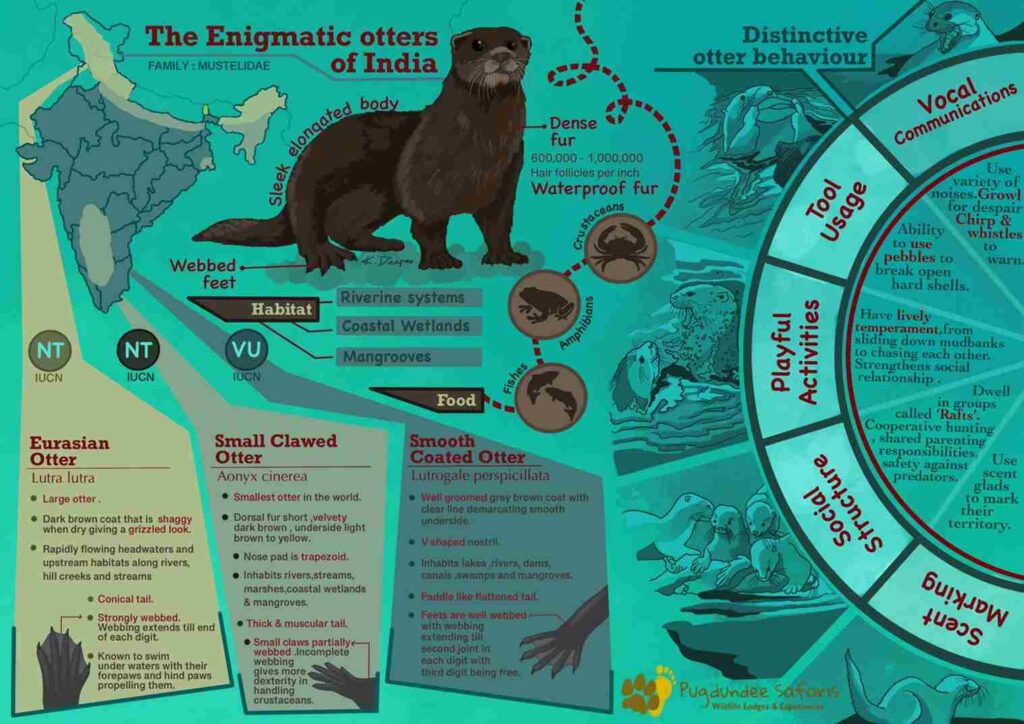
“With tails like oars, they carve the streams,
In playful spins and silver gleams,
Their fur, a coat of velvet sheen
The finest cloak the wild has seen”
A cute animal playing with pebbles? Hiding its pebble in a pocket? floating away in water while sleeping – ever wondered what these animals are? Adorable semi-aquatic mammals, otters are members of the Mustelidae family of mammals, which also includes ferrets, badgers, and weasels. These elegant and gregarious animals are renowned for their social behaviour, intelligence, and dexterity in the hunt.
In this blog, let’s dwell on the intriguing behaviours, eating patterns, and conservation initiatives put in place to preserve these cherished animals as we explore otters in India. Otters, whether sliding down riverbanks or floating on their backs while breaking open shellfish, they remind us of nature’s beauty and complexity, making their conservation all the more important.
What are Otters?
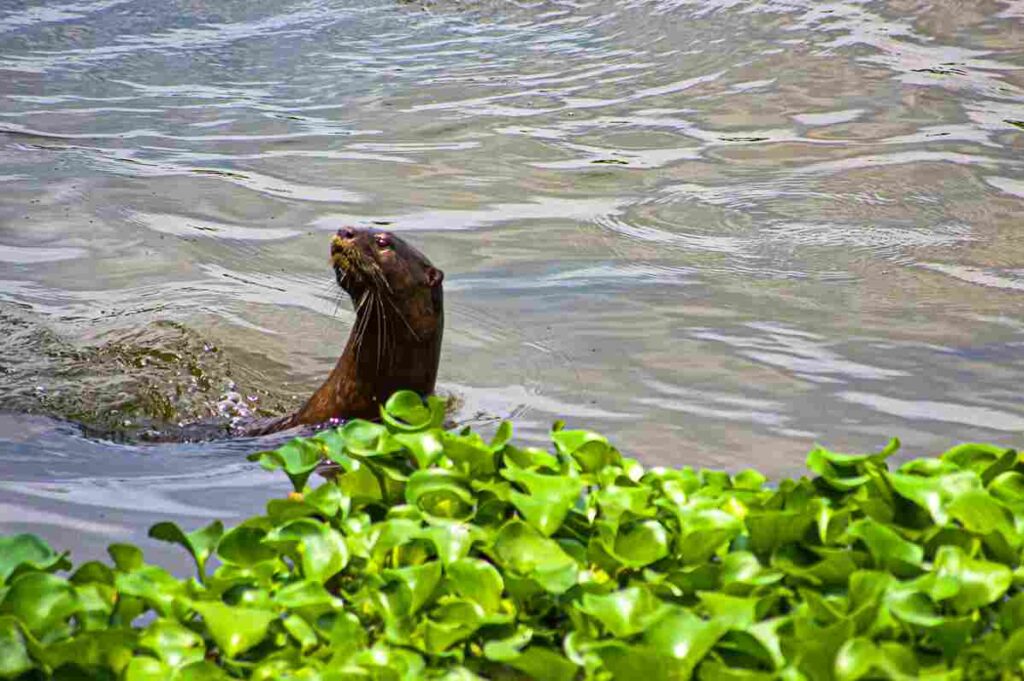
Easily identified by their sleek, elongated bodies, webbed feet, and thick fur, otters are interesting mammals. Otters are skilled swimmers who use their webbed feet to paddle through water and their streamlined bodies to glide with ease. They have adapted to a semi-aquatic lifestyle. These mammals hunt for fish, amphibians, crabs, and other aquatic life in freshwater and coastal habitats where they have evolved to flourish.
There are 3 Otter Species in Indian Wildlife
There are three species of Otters in India. Each with distinct characteristics and habitat preferences. Let’s take a closer look at each species.
1. Smooth-coated otter (Lutrogale perspicillata)
IUCN: Vulnerable
In India, the smooth-coated otter is the most common species to be seen and observed. With adults reaching lengths of up to 1.2 meters, it is larger than the other two species. This otter, as its name implies, has a shorter coat than other otters and is smooth and shiny. Highly gregarious creatures, smooth-coated otters frequently reside in family units made up of a breeding pair and their young.
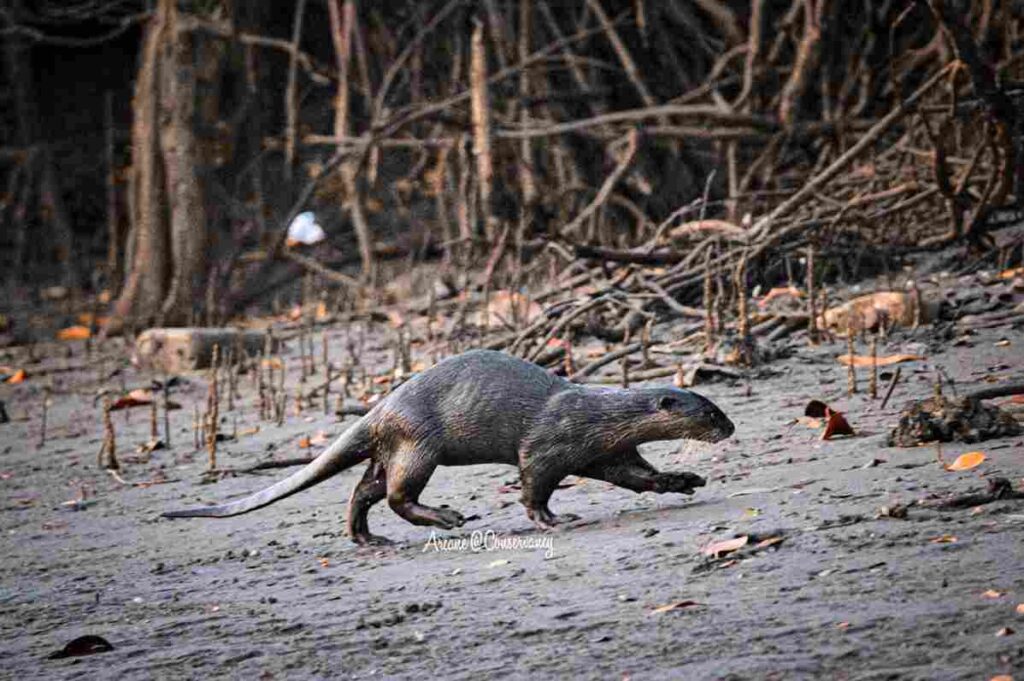
The Smooth-coated otter occurs throughout South Asia and Southeast Asia. In India, it is distributed in all the major rivers south of the Himalaya. They can be found in marshes, lakes, and rivers, among other watery environments. They have also been observed in mangroves and coastal wetlands in certain places. Although their food is mainly composed of fish, smooth-coated otters may occasionally eat crustaceans, amphibians, and small mammals.
2. Asian Small-Clawed Otter (Aonyx cinereus)
IUCN: Near threatened
The smallest otter species is the Asian small-clawed otter, which can grow up to 90 centimetres in length as adults. Its feet are somewhat webbed, unlike those of other otter species, which reduces its reliance on water for hunting. This species is known for its dexterity; it frequently uses its delicate forepaws to capture small fish, molluscs and crabs.
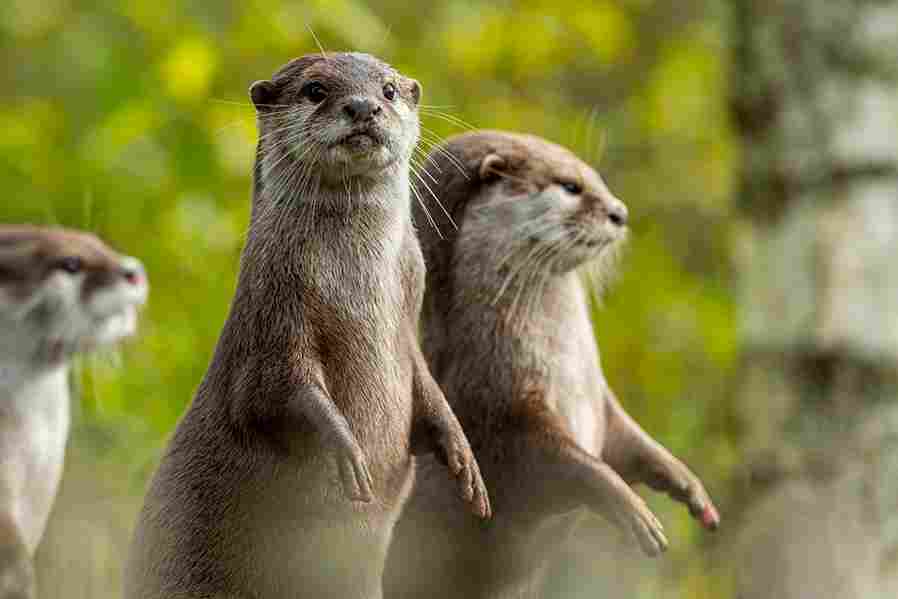
Asian small-clawed otters are usually found in hilly or forested environments near freshwater streams, swamps, and rice fields. Asian small-clawed otters are found in southern India, southern China, Southeast Asia, Indonesia and the Philippines. They are more elusive than smooth-coated otters. They are renowned for their intricate social structures and vocalizations, which involve making a range of noises to convey messages to one another.
3.Eurasian Otter (Lutra lutra)
IUCN: Near Threatened
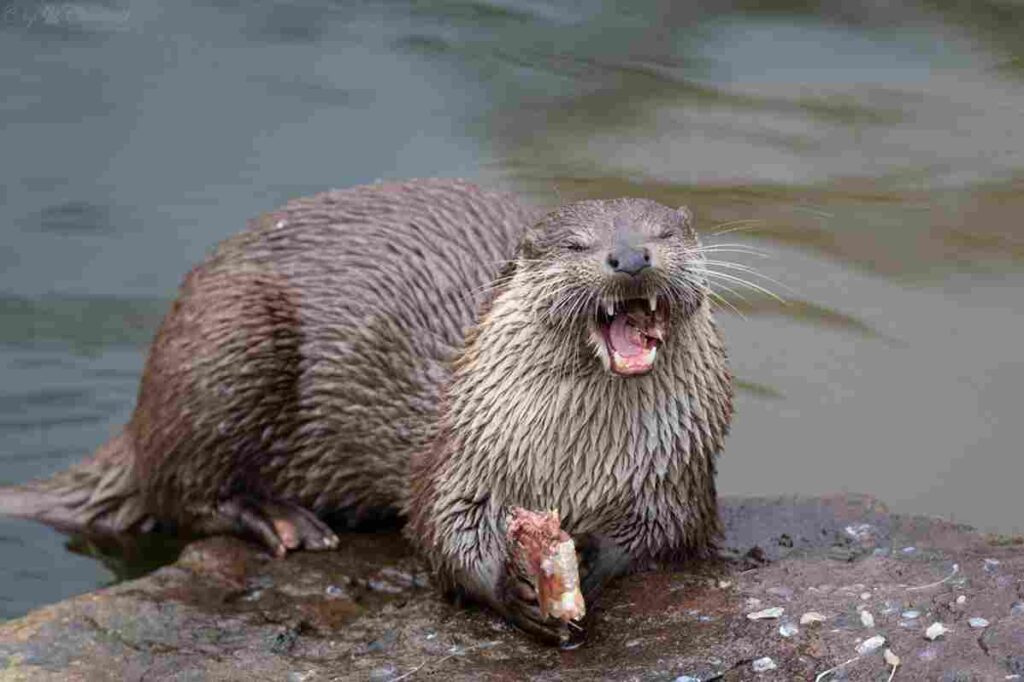
The most extensively distributed otter species is the Eurasian otter, sometimes referred to as the common otter, which can be found in portions of Africa, Asia, and Europe. It is found throughout the northeastern states of India as well as the foothills of the Himalayas. Unlike the other two species found in India, this one is more elusive and solitary. Eurasian otters enjoy clear, swift rivers with lots of fish and hiding places for the purpose of denning.
There are (13) thirteen species of otters recognised worldwide, and each has distinct traits and ecological functions. Some like the sea otters, are well-known for their tool use, while others, like the gigantic otters, are honoured for their vocal communication and social systems
best places to see otters in india
Smooth-coated Otter (Lutrogale perspicillata)
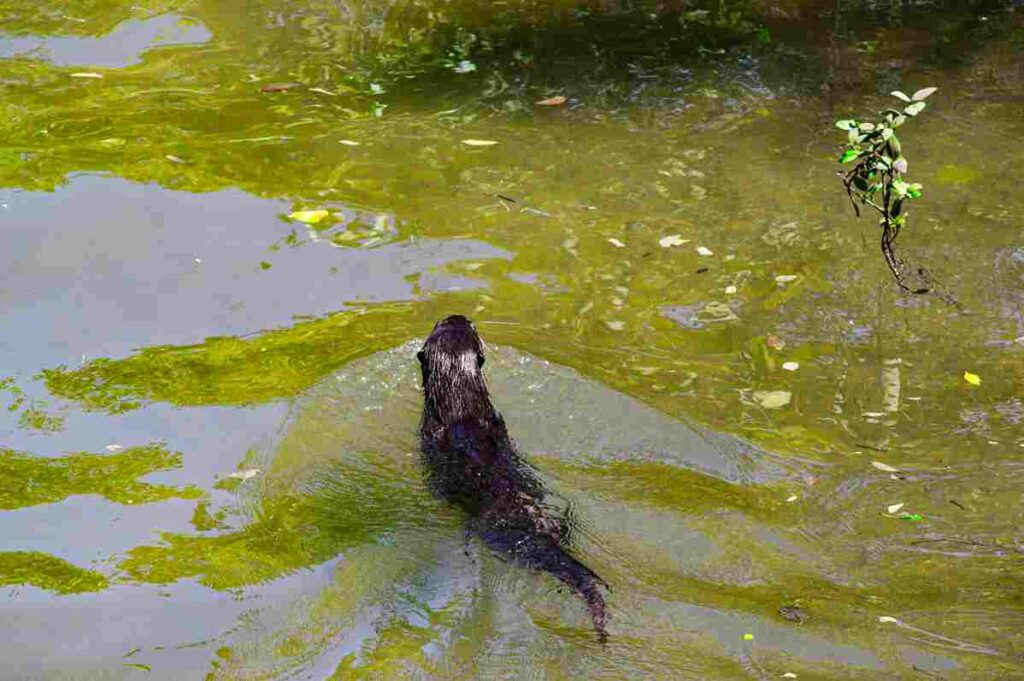
- Kumarakom Bird Sanctuary, Kerala: Frequently observed in the backwaters and lakes.
- Sundarbans National Park, West Bengal: Present in tidal waters and mangrove areas.
- Chambal River National Sanctuary, Madhya Pradesh: Commonly seen along riverbanks and during boat excursions.
- Kaziranga National Park, Assam: Often located near water bodies, especially in wetland regions.
- Bhitarkanika National Park, Odisha: Typically found in estuarine environments and mangroves.
- Periyar Wildlife Sanctuary, Kerala: Regularly spotted around the lakes and rivers in the sanctuary.
Eurasian Otter (Lutra lutra)
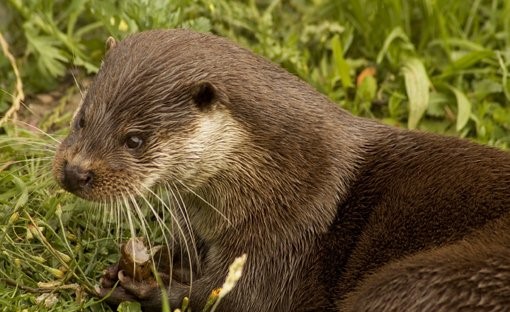
- Nagarhole National Park, Karnataka: Found in the park’s rivers and streams.
- Panna National Park, Madhya Pradesh: Occasionally seen in various water bodies and along riverbanks.
- Himalayan Regions: Some populations exist in higher altitude streams, although specific reserves are not extensively documented.
Small-clawed Otter (Aonyx cinerea)
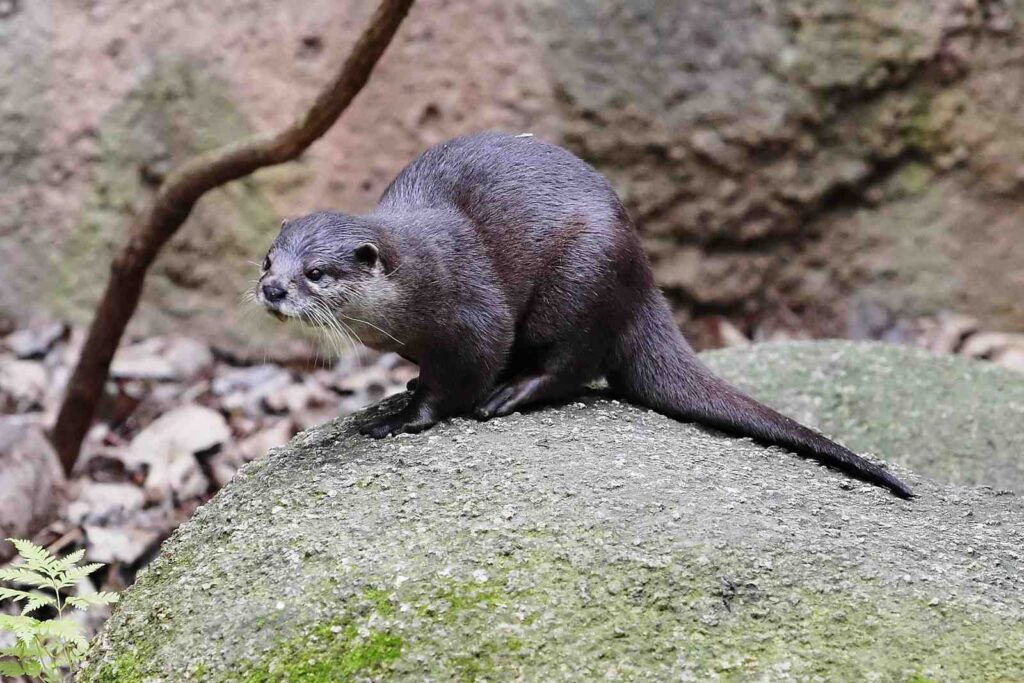
- Kaziranga National Park, Assam: This UNESCO World Heritage Site is renowned for its biodiversity and offers suitable wetland habitats for small-clawed otters.
- Manas National Park, Assam: Another UNESCO World Heritage Site, Manas has riverine ecosystems and wetlands that are ideal for these otters.
- Sundarbans National Park, West Bengal: The park’s mangrove forests and estuarine regions create perfect conditions for small-clawed otters.
- Bhitarkanika National Park, Odisha: The complex network of rivers and mangroves in this park supports diverse wildlife, including small-clawed otters.
- Nameri National Park, Assam: This park’s riverine habitats make it a good location for spotting these otters.
Where do otters live and what do they eat?
Riverine Systems
Otters have perfect homes in India’s extensive riverine systems, which include the Ganges, Brahmaputra, and their tributaries. The abundant biodiversity of these river systems supports a wide range of aquatic species, including fish, amphibians, and crustaceans, otters being carnivores all of these food sources play a crucial role. Large rivers and lakes are especially well-suited for the smooth-coated otter because they provide it with plenty of food and refuge. The Eurasian otter, on the other hand, favors colder, clearer rivers, especially those in the northeast and Himalayan regions.
Coastal Wetlands and Mangroves
Otters also depend on coastal wetlands and mangroves, like the West Bengal Sundarbans, for their habitat. Fish and other aquatic life abound in these habitats, offering a plentiful supply of food. In these regions, smooth-coated otters are frequently spotted hunting and are an important part of the ecosystem’s health because they regulate fish populations and keep the water clear. Otters can also find refuge and defense against predators in mangroves. These habitats are seriously threatened, nonetheless, by human activity’s destruction of mangrove forests.
ECOLOGICAL IMPORTANCE OF OTTERS
Otters are the top predators in their habitats, serving as markers of good aquatic environments. Their existence suggests clear water and a healthy population of fish and other prey species. Otters contribute to the balance of aquatic ecosystems by managing fish and invertebrate populations, which influences the entire food chain. Because otters require clean water and abundant prey to survive, their presence in a water body is a sign of good environmental health. Conversely, the absence of otters from an area where they were once found can signal pollution, habitat degradation, or overfishing.
Distinctive behaviour OF otterS
Playful Activities
Otters are well-known for their lively temperament. Otters appear to have unlimited energy for play, whether they’re sliding down muddy banks, chasing each other, or performing aquatic acrobatics. This playful behaviour serves a variety of purposes:
Social Bonding: Play strengthens social relationships within groups, encouraging cooperation and teamwork. Young otters gain important hunting and social abilities through play.
Tool Usage
Sea otters are particularly well-known for their ability to use tools. They frequently utilize pebbles to break open the hard shells of sea urchins and other shellfish. This behaviour demonstrates their intelligence and problem-solving ability, since they can choose the appropriate tool and store it in a “pocket” of skin under their forearms for later use.
Vocal communication
Otters are very noisy animals that use a variety of noises to interact with one another. These noises may consist of:
Whistles and chirps: frequently used to warn or interact with other dogs in the group.
Growls and grunts: May be used to express hostility or despair.
Social Structures and Rafts
Many otter species are sociable creatures. They frequently dwell in groups known as rafts, which can number up to twenty distinct individuals. This social organization offers various benefits. It provides safety in numbers against predators. Group living allows for cooperative hunting and shared parenting responsibilities, with adults assisting in the care of offspring.
UNIQUE FEATURES OF OTTERS
Scent Marking
Otters possess scent glands that they use to mark their territory. By leaving these scent markings, they communicate their presence and define their boundaries with other otters. This behaviour plays a crucial role in minimizing conflicts and maintaining social harmony.
Dense Fur
Otters have the thickest fur of any marine mammal, with around 600,000 to 1,000,000 hair follicles per square inch. This dense fur traps air, providing excellent insulation against cold temperatures.
Waterproofing
Their fur is also designed to be water-resistant. The outer layer of fur helps keep water away from their skin, while a layer of trapped air keeps them warm.
Conservation Status and Threats
The International Union for Conservation of Nature (IUCN) has classified all three of the otter species that can be found in India as being in different threat categories. The Asian small-clawed otter is considered Near Threatened, whilst the smooth-coated otter is listed as Vulnerable. In India, the Eurasian otter is considered Near Threatened, but worldwide, its status is Least Concerned.
Habitat Loss and Fragmentation
The loss of their habitat is one of the main dangers to otters in India. The destruction or fragmentation of riverine and wetland ecosystems is a result of human activities like agriculture, urbanisation and water reservoirs. The normal flow of rivers is disrupted by dams and irrigation projects, which has an impact on fish populations and lessens the amount of food available for otters.
Poaching and Illegal Wildlife Trade
Otter fur is sought for and highly prized in the illegal wildlife trade. Otter pelts are frequently trafficked into foreign markets to be used in the production of opulent clothing. Furthermore, fishermen who see otters as rivals for fish occasionally kill them. Even though it’s forbidden to hunt otters in India, rules protecting wildlife are nevertheless hard to execute.
Pollution and Water Degradation
Another significant challenge to otter populations is water pollution from untreated sewage, industrial waste, and agricultural runoff. In addition to decreasing the amount of prey available, contaminated water bodies cause direct injury to otters by allowing toxins to enter their bodies. Fish and other prey can become contaminated by pesticides and heavy metals, which can cause otter poisoning.
Key Conservation Efforts
Habitat Restoration
Many organizations work on rehabilitating wetland areas and riverbanks to create suitable environments for otters.
Research and Monitoring
Various groups carry out studies to track otter populations and their health, which is essential for developing effective conservation strategies.
Public Education
Educational initiatives aim to raise awareness about the ecological significance of otters and the challenges they encounter.
Cultural Significance of Otters in India
Otters appear in the folklore and traditions of many Indian cultures. In some places, they are adored for their agility and cleverness, while in others, they are linked to water deities. Otters are also featured in ancient Indian scriptures, like as the Jataka stories, where they are shown as intelligent and resourceful creatures.
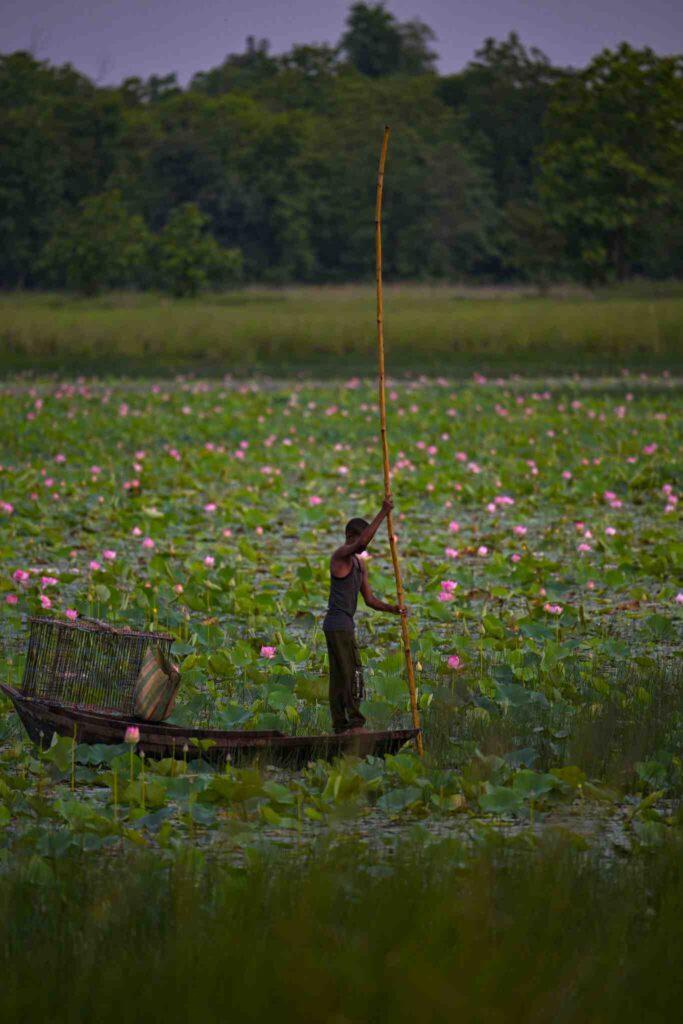
Traditional fishing tribes in north-eastern India have established a special symbiotic relationship with otters. It has been customary for fishermen in regions like West Bengal and Assam to employ trained otters to assist them in catching fish; this practice stretches back several generations. However, because of the decrease in otter numbers and modifications to fishing methods, this custom is now uncommon.
Written by Shaheen Shaikh, Naturalist at Pugdundee Safaris
References:
1. Foster-Turley, P., Macdonald, S., & Mason, C. (1990). Otters: An Action Plan for Their Conservation. IUCN.
2. Hall, E. R. (1981). The Mammals of North America. New York: John Wiley & Sons.
3. Hussain, S. A. (1999). Reintroduction of the Smooth-coated Otter in the Eastern Sundarbans Reserved Forest, Bangladesh. Oryx.
4. International Otter Conservation. (n.d.). Otter Species & Evolution. Retrieved from International Otter Conservation
5. International Otter Survival Fund. (2010). Otter Species in India.
6. MacDonald, D. W., & Mason, R. F. (2000). The Biology and Conservation of the Otter. Animal Conservation, 3(2), 181-192. DOI:10.1111/j.1469-1795.2000.tb00180.x
7. Mason, C. F., & Macdonald, S. M. (1986). Otters: Ecology and Conservation. Cambridge University Press.
8. Menon, V. (2014). Indian Mammals: A Field Guide. Hachette India.
9. Nawab, A., & Hussain, S. A. (2012). Ecology of Smooth-coated Otter in the Upper Ganges Basin, India. Hydrobiologia, 748(1), 75-87.Institute of India.
10 Yurchenko, A. A., et al. (2017). Molecular Phylogeny and Evolution of Otters (Family Mustelidae). Molecular Phylogenetics and Evolution, 115, 138-150. DOI:10.1016/j.ympev.2017.08.010

